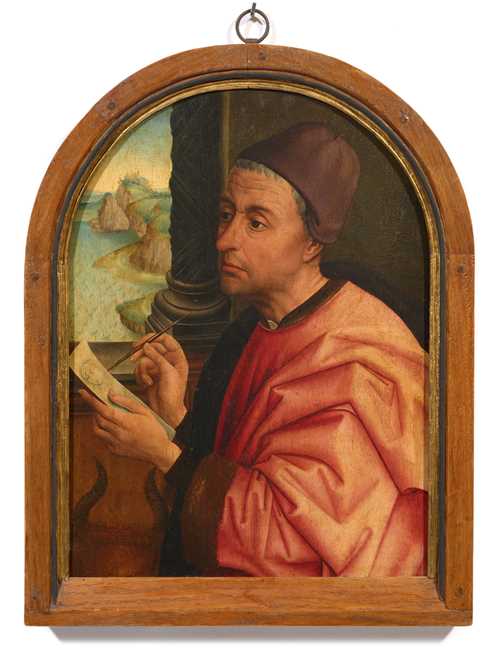
Lot 1848 - S19 La Collection de Dre Sylvia Legrain - mercredi, 20. septembre 2023, 10h00
Studio of ROGIER VAN DER WEYDEN
- With Friedrich Carl Delius Giese, London, 1938.
- Private collection, Switzerland.
- Sale Koller, Zürich, 30.3.2012, Lot 3009.
Dendrochronological analysis by Prof. Peter Klein from 18.6.2011 who assumes the date to be from 1462 onwards.
This panel with Saint Luke making a sketch of the Madonna was probably once part of a diptych for personal devotion, with Mary and the Christ Child on the opposite panel. Luke is depicted in a particularly concentrated and contemplative manner, underlining the intimate character of this representation. In the lower left corner, one recognises the head of a bull, the Evangelist’s symbol. The composition recalls a section of an altarpiece by Rogier van der Weyden which was painted around 1435–50 and is now in the Museum of Fine Arts in Boston (inv. no. 93.153, oil on panel, 137.7 × 110.8 cm). It shows St Luke drawing and Mary seated opposite him, nursing the Christ Child. A wide river landscape is visible through a window framed with columns in the background. This subject matter was particularly associated with the painters’ guild, whose patron was St Luke, and it is assumed that Rogier van der Weyden’s altarpiece was intended for the Brussels guild. Several exact copies exist of this prototype (see Lorne Campbell and Jan Van der Stock: Rogier van der Weyden. 1400–1464. Master of Passions, Zwolle 2010, cat. no. 41, pp. 399–402). Hélène Mund mentions that Weyden’s physiognomy was possibly used for the depiction of the Evangelist, and that the production of diptychs with Luke in half-figure profile flourished especially as an homage to the Evangelist, but also as a nod to the artist himself (see Campbell/Van der Stock 2010, p. 406). According to the dendrochronological analysis, our panel was created in 1456 at the earliest, more probably around 1462. Stylistically, however, it can be considered to have been made about 20 years earlier. A preparatory drawing from the workshop of Rogier van der Weyden probably served as a model. According to current knowledge, it can be assumed that after van der Weyden’s death his son, Peter, took over his father’s workshop.
A comparable version, dated around 1501 and 1517 on the basis of the coat of arms on the reverse of Philip the Bastard of Burgundy, later Bishop of Utrecht, is in the National Gallery of Ireland in Dublin (inv. no. NGI.4).
CHF 80 000 / 120 000 | (€ 82 470 / 123 710)
Vendu pour CHF 300 000 (frais inclus)
Aucune responsabilité n'est prise quant à l´exactitude de ces informations.


